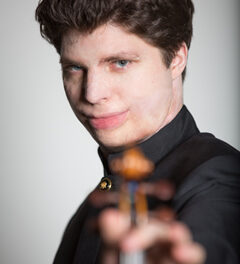Brevard Music Center’s chamber music series moved deeper into the summer schedule with a wonderful program of Mozart, Bach, and Rachmaninov presented in Brevard College’s Porter Center by the Díaz Trio with Bruce Murray at the piano. The hall was full, and the sheer number of string players in the audience was enough to create a band every weekend – and they do: it’s called the BMC Orchestra. You might say this audience was pre-disposed to be impressed.
But there was something distinctly different about the sound this night. We’ll get to that in a minute.
This program started off with Mozart’s Sonata No. 32 in B-flat, K.454, with Andrés Cárdenes doing the violin work and Murray accompanying him. It has a typical fast, slow, fast format, and the long middle movement is both tasty and long. Throughout, it was clear that Cárdenes, Concertmaster of the Pittsburgh Symphony and Professor at Carnegie Mellon University, has the skills and big sound common to front-rank violinists, but this time he delivered an even pallet of sound consistent with the period.
Next we heard the Sixth Brandenburg Concerto (S.1051) of J.S. Bach, also in the key of B-flat. This ensemble included the other two Díaz Trio members – Andrés Díaz, cello, and Roberto Díaz, viola – along with violists Eric Koontz, Scott Rawls, and Thomas Rosenthal, and Craig Brown, double bass. That’s right! Four violas, cello, and bass. Quite a mix too, because not all the violas were the same size. This made for a wonderful and lush sound, combined with brisk tempos and great playing. It was a real treat to hear, marred only by confusing program credits that listed Koontz and Rosenthal playing viola da gamba. There was no such thing on stage and no effort was made to clarify the error. This was odd because you’d think somebody would have come forward to help unaware students or local patrons distinguish between violas of different sizes and instruments of antiquity dating from the baroque!
After intermission, Murray returned to accompany Andrés Díaz in the Sonata in G minor, Op. 19, for cello and piano, by Sergei Rachmaninov. That’s a minor third away from everything we heard in the first half and a tough key anyway. The work is in four movements: Lento-Allegro moderato, Allegro scherzando, Andante, and a great Allegro mosso that almost has a Stephen Foster motive. Díaz, the ’86 Naumburg winner, showed why his playing is so highly regarded, and a big time romantic work is just the ticket for displaying all of a cellist’s skills. The playing was brilliant by both musicians. The sound was not.
This is the subject that had been nagging at me since the early Mozart. Cárdenes apparently understood the problem; therefore his restrained playing may have been the key to not draw as much attention. Here are the problems: the piano was very pointed and harsh in both the Mozart and Rachmaninov. The string ensemble in the Bach had a very in-your-face and rough edge to it. It was not enough to spoil the performance, but it was certainly different enough from similar ensembles in this same hall. Then I noticed Andrés Díaz’s sound had a grainy quality about it. It was not how I remember his playing, and it was not distinct enough to be “on purpose” or a specific choice by the player. Throughout the last piece, the quality of the sound was simply not pleasant.
Finally, I noticed the row of acoustic shells immediately behind the players. This is new because we rarely see such shells in this hall. I asked the Music Center why they were used. They wrote back and said it was a decision by the Díaz Trio. I still don’t know what factors drove this decision, but it was obviously a mistake. By using that particular enhancement, they took the hall out of the equation and created something not as good. The shells acted to propel the sounds, warts and all, with more force, straight out into the audience. No help! They won’t do that again – or at least I hope they don’t!












